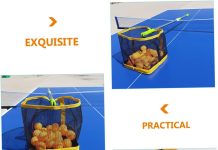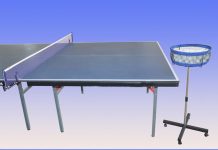Table tennis, also known as ping pong, is a game that may seem deceptively simple at first glance.
Yet, anyone who has ever picked up a paddle and attempted to play the sport knows it requires unique skills and abilities.
From lightning-fast reflexes to precise hand-eye coordination, table tennis challenges players to think and react even more quickly.
The fast-paced nature of the game, combined with the need for precise technique and agility, makes table tennis a challenging sport to master.
So, why is table tennis hard to play? Let’s explore some of the reasons behind the difficulty of this beloved sport.
Review contents
Speed and Quick Reflexes
The fast-paced nature of the game
Table tennis is a sport known for its lightning-fast pace. The small size of the table and the quick back-and-forth nature of the game make it incredibly challenging to keep up with the speed. As a player, you must constantly be on your toes, anticipating your opponent’s moves and reacting with lightning-fast reflexes. The fast-paced nature of table tennis requires an elevated level of agility and quick thinking.
Need for quick reaction time.
In table tennis, every second counts. The ball can travel at incredible speeds, and you have only a split second to react and return each shot. Your reaction time will be tested as you try to anticipate your opponent’s shots and respond with precision. Developing quick reflexes is essential to keep up with the fast pace of the game and return shots effectively.
Challenges in returning fast shots
Returning fast shots in table tennis can be pretty challenging. The speed at which the ball travels, combined with the spin it carries, makes it difficult to control and accurately send it back to your opponent.
You have to not only react quickly but also maintain control over your shot. The combination of speed and precision required in returning fast shots adds to the overall difficulty of playing table tennis.
Precision and Control
Accuracy required for shots
Table tennis is a game of millimeters. The small size of the table and the net height make it crucial to have precise control over your shots. Accuracy is paramount whether you’re delivering a powerful offensive strike or a delicate defensive stroke. A slight miscalculation or misplacement of the ball can mean the difference between winning and losing a point. Developing the ability to hit your targets with pinpoint accuracy consistently is a skill that requires practice and focus.
Fine motor skills
Table tennis demands excellent coordination and control of fine motor skills. The delicate touch required to manipulate the paddle and gently guide the ball requires high precision.
You need to be able to vary the strength and speed of your shots, as well as apply the appropriate spin to outwit your opponent. Developing and refining your fine motor skills through consistent practice is critical to mastering the art of table tennis.
Mastering different spins
Spin is a critical aspect of table tennis that adds another layer of complexity to the game. There are various types of spins, including topspin, backspin, sidespin, and combinations. Each type of spin affects the trajectory and bounce of the ball, making it challenging for your opponent to return your shots.
Mastering the different spins and recognizing and adapting to your opponent’s spin can give you a significant advantage on the table.
Hand-Eye Coordination
Tracking the ball’s movement
Hand-eye coordination is crucial in table tennis. As the ball zips back and forth across the table, your eyes must accurately track its movement to time your shots effectively. You need to be able to anticipate where the ball is going to land and position yourself accordingly. The ability to visually track the ball’s movement and coordinate your hand movements to hit it at the right moment is a skill that requires practice and focus.
Timing the shots
Table tennis is all about timing. To hit the ball precisely, you must time your shots perfectly. This requires syncing the movement of your hand and paddle with the ball’s trajectory. Being even slightly off in your timing can result in a missed shot or an ineffective return. Developing a keen sense of timing through consistent practice is essential to become a skilled table tennis player.
Reacting to unexpected changes
Table tennis is a game of surprises. Your opponent may throw unexpected shots at you, varying the direction, speed, and spin of the ball.
Your ability to react quickly and adjust your shots accordingly is vital to control the game. Developing agile hand-eye coordination enables you to adapt to these unpredictable changes and maintain your competitive edge on the table.
Footwork and Agility
Constant movement on the table
Footwork is an often-overlooked aspect of table tennis, but it plays a significant role in your overall performance. Constant movement is required to position yourself optimally for each shot and quickly cover the table.
A player with good footwork can reach wide shots, return the ball from deep positions, and maintain balance throughout the game. The ability to move swiftly and smoothly across the table is a valuable skill in table tennis.
Quick changes in direction
Table tennis requires you to change direction rapidly and frequently. Your opponent may hit the ball to different table parts, requiring you to adjust your position to return the shot effectively and quickly.
The ability to change direction swiftly and smoothly is crucial to maintain control and keep up with the game’s fast pace. Developing agility and quick reflexes through specific footwork drills and training exercises will enhance your performance on the table.
Balance and agility to reach wide shots
Table tennis often demands that you stretch and reach for wide shots. It requires flexibility, balance, and agility to maintain control in these challenging positions. Being able to reach these shots without losing your balance and quickly recover to a neutral position is essential.
Strengthening your core muscles and practicing specific exercises to improve your balance will enable you to reach wide shots and maintain your gameplay consistency effectively.
Strategy and Decision Making
Analyzing opponents’ playing style
Successful table tennis players understand the importance of analyzing their opponents’ playing style. By observing your opponent’s strengths, weaknesses, and preferred shot selection, you can devise strategies to exploit their vulnerabilities and maximize your chances of success. This requires an astute understanding of the game and the ability to make quick assessments during the match.
Adapting strategies during the game
Table tennis is a dynamic sport, and the ability to adapt your strategy during a match is crucial. As the game progresses, you may need to adjust your tactics based on changes in your opponent’s playing style or the game’s overall flow. This requires thinking on your feet, making quick strategic decisions, and altering your game plan accordingly.
Making split-second decisions
Split-second decisions often decide table tennis. During a fast-paced rally, you must react quickly and make decisions in a fraction of a second. Choosing the right shot to play, whether offensive or defensive, can significantly impact the outcome of the point. Developing the ability to make quick and accurate decisions under pressure is a skill that can make the difference between winning and losing a game.
Psychological Factors
Dealing with pressure and stress
Table tennis can be a mentally demanding sport, especially during intense matches or competitions. The pressure to perform and meet expectations can sometimes lead to stress and anxiety. Managing and coping with pressure is essential for maintaining focus and performing at your best. Strategies such as deep breathing, positive self-talk, and visualization can help you relax and remain composed during crucial moments.
Maintaining focus and concentration
Table tennis requires a high level of focus and concentration. It’s essential to stay fully present at each point, anticipating your opponent’s shots and reacting quickly. Any lapse in concentration can result in a missed shot or a loss of control. Developing mental discipline and concentration through mindfulness exercises and mental training can enhance your ability to maintain focus throughout the game.
Overcoming nerves and anxiety
Nerves and anxiety can be expected in table tennis, especially when playing in front of an audience or during important matches. Managing nervousness and anxiety is essential for maintaining a clear mind and playing to your potential. Techniques such as visualization, positive affirmations, and pre-match routines can help calm nerves and boost confidence, allowing you to perform at your best, even in high-pressure situations.
Physical Fitness Requirements
Endurance for long rallies
Table tennis matches involve long, relentless rallies that test players’ endurance. The ability to sustain a high level of performance throughout the match is crucial. Endurance training, such as cardio exercises, can improve your stamina, allowing you to perform at your peak during extended rallies and matches consistently.
Flexibility for reaching low shots
Flexibility is another physical attribute that contributes to success in table tennis. The ability to reach low shots without straining or losing balance is essential. Regular stretching exercises, such as yoga or dynamic stretching routines, can improve your flexibility, enabling you to reach low shots more effectively without sacrificing stability.
Strength and power for aggressive shots
Table tennis requires a combination of finesse and power. While precision is essential, there are times when you need to deliver aggressive shots to gain an advantage. Developing strength and power in your strokes, particularly in your forehand and backhand, can give you an edge in overpowering your opponent and hitting winners. Strength training, focusing on exercises that target the specific muscles used in table tennis, can help enhance your shot power.
Table Tennis Techniques
Mastering different strokes
In table tennis, there are various strokes to master, each with its own technique and purpose. The forehand loop, backhand flick, topspin drive, and push are just a few examples of the many strokes in the sport. Mastering these strokes involves understanding the proper technique, developing muscle memory through repetition, and honing your skill through consistent practice. Each stroke requires a unique combination of footwork, body positioning, and paddle movement.
Developing effective serves
Serving is not just a way to start a point; it can also be a potent offensive weapon in table tennis. Developing effective serves can give you an advantage by putting your opponent on the defensive right from the start.
Different types of serve, such as the pendulum, backhand, or sidespin, require specific techniques and strategies. Experimenting with different types of serves and practicing their execution will improve your overall game and keep your opponents guessing.
Understanding spin and its impact
Spin is an intrinsic part of table tennis and can significantly affect the trajectory and behavior of the ball. Understanding the different types of spin, such as topspin, backspin, sidespin, and variations of these, allows you to anticipate and adapt to the ball’s movement. Training exercises focusing on reading spin, such as multi-ball drills or practicing against various spins, will enhance your ability to recognize and respond to different types of spin effectively.
Equipment and Table Conditions
Choosing the right racket
Choosing the right racket is crucial for your performance in table tennis. Grap size, blade composition, and rubbers significantly impact your playing style. A racket that suits your style and preferences can improve your comfort and control on the table. Experimenting with different rackets and seeking guidance from experienced players or coaches can help you find the racket that best suits your game.
Adapting to different table surfaces
Table tennis can be played on different surfaces, each with unique characteristics. Surfaces can vary in terms of bounce, speed, and grip. Adjusting to different table surfaces requires quick adaptation and the ability to read and adjust to changing conditions. Regularly practicing on various table surfaces, such as outdoor tables or tables with different coatings, can help you develop the versatility to perform well under different conditions.
Adjusting to varying lighting conditions
Lighting conditions can significantly impact your visibility and perception of the ball in table tennis. Playing under bright lights or in dimly lit areas can present challenges in accurately tracking the ball’s movement. Adapting to varying lighting conditions involves training your eyes to quickly adjust to changes in brightness and contrast. Practicing under different lighting conditions or using specialized eyewear designed for table tennis can help you adapt and perform optimally in different lighting environments.
Training and Practice
Consistency and repetition
Consistency and repetition are essential in developing any skill, and table tennis is no exception. Regular practice is essential to train your muscles, refine your techniques, and build the muscle memory required for effective shot execution. Consistent training helps you develop the necessary physical and mental attributes to perform well in the sport.
Working on specific skills
To improve in table tennis, it’s essential to identify and work on specific skills. Whether improving your footwork, enhancing your backhand, or perfecting your serves, dedicating focused time to work on specific skills can significantly accelerate your progress. Breaking down complex skills into smaller components and practicing each component individually allows you to master the skill as a whole.
Simulating game scenarios
Table tennis matches are unpredictable, and practicing specific game scenarios can help you better prepare for real-game situations.
By simulating match-like conditions in your practice sessions, such as practicing against different opponents or playing practice matches with specific rules, you can enhance your ability to make quick decisions, adapt to varying strategies, and improve your overall match performance.
In conclusion, table tennis is a challenging sport requiring physical skills, mental focus, and strategic thinking. The speed and quick reflexes, precision and control, hand-eye coordination, footwork and agility, strategy and decision making, psychological factors, physical fitness requirements, table tennis techniques, equipment and table conditions, and training and practice all contribute to the complexity and difficulty of the game.
By recognizing and addressing these challenges, and through consistent training and practice, you can unlock your potential and excel in the exhilarating sport of table tennis.




























![Best Outdoor Dartboards [Reviews and Buying Guide 2024] Best Outdoor Dartboards](https://gamersets.com/wp-content/uploads/2022/12/Best-Outdoor-Dartboards-100x70.jpg)

![Best Mini Air Hockey Table [Reviews & Buying Guide 2024] Best mini air hockey table](https://gamersets.com/wp-content/uploads/2022/10/Best-mini-air-hockey-table-100x70.jpg)







